Bottling
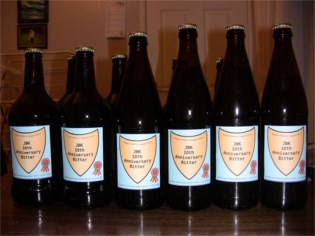
Racking and Priming
If you are bottling your beer, it's best to rack it into a separate bucket first. This could be a spare fermenter or unused pressure barrel, preferably one with a tap to allow a bottling stick to be easily attached (much easier than mucking about with syphons).
The big advantage of using a separate bucket is that you can 'bulk' prime the beer before you put it in the bottles. If you bottle straight from the fermenter the only practical way to prime the beer is to add the priming sugar to each bottle individually (which is more time consuming and error-prone).
Finings
Given the right storage conditions, well-made bottled beer should clear without the need for finings. Isinglass and gelatine both produce unstable deposits and while this is OK for a pressure barrel or cask, I do not recommend using either in bottled beer.
Priming Options for Bottling
Bottling Bucket
- Add 60 - 80g (2 - 3oz) of granulated sugar to the whole batch and stir to thoroughly dissolve and distribute it through the whole batch (be careful not to stir air into the beer though - stir gently!). I prefer to dissolve the sugar in a small amount of hot water first, then boil it briefly to sterilise it before adding to the bulk of beer.
- Brown sugars, caster sugar and glucose can also be used, though the quantity may need to be adjusted to allow for the different extract in each.
- Dried or liquid malt extract can also be used to prime.
Straight From The Fermenter
- Using any suitable sugar (see above) add half to one level teaspoon of sugar to each bottle. This can also be added as a syrup if you have an accurate means of measuring how much you add.
- Add a proprietory carbonation drop to each bottle (check the manufacturer's instructions to get more or less carbonation by varying the number of drops in each bottle)
Bottle Washing and Sterilising
This is without a doubt the main down side of bottling! Each bottle needs to be washed clean, then sterilised with your choice of product. After sterilising, (unless you are using a no-rinse sanitiser) the bottles must be rinsed clean with tap water and drained. Don't forget to also sterilise the crown caps.
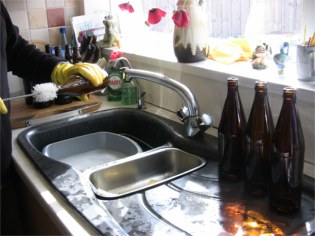
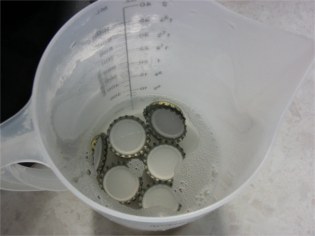
Filling The Bottles
While it's possible to fill bottles using a jug (I did exactly that in my early days of brewing) it's time-consuming, messy and results in spillage and therefore loss of beer - not what we want! Far better is use a device called a bottling stick.
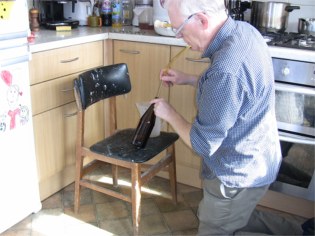

A bottling stick is a hollow plastic stick with a valve on the end. The stick is attached to the tap of the bottling bucket or fermenter with plastic tubing, and the tap opened. The valve at the bottom of the stick prevents beer flowing until it is pressed up against the bottom of a bottle, at which point it opens and allows beer to flow into the bottle. When the bottle is full, the stick is lifted up and the flow stops. The process is repeated for each bottle in turn.
Capping
If you are using normal beer bottles, these will take crown caps, for which you will need a capper. Various types are available and the price generally reflects the convenience of use.
- Hammer on cappers - cheap and nasty; avoid at all costs!
- Two lever cappers - moderately priced and work well, but have difficulty with certain bottle necks
- Bench cappers (see picture) - the most expensive but also the easiest and quickest to use.
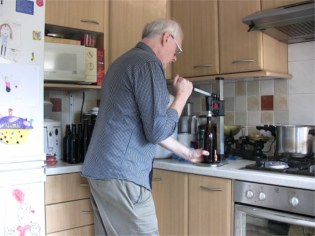

Pouring From The Bottle
Most commercial bottled beer can be poured straight from the bottle without taking much care about it. Bottle conditioned beer, however, must be handled with a little more finesse to avoid disturbing the yeast deposit in the bottom - and our home brew is, of course, bottle conditioned.
Hold the glass at an angle and slowly slide the beer into it, gradually bringing the glass upright as it fills. Look through neck of the bottle and watch the beer as it passes; as soon as you see a cloudy patch of yeast, stop pouring. With practice and a good solid yeast deposit it's possible to pour almost all of the beer leaving only a tiny amount in the bottle - aim for maybe 5 - 10mm left.
If you like a head on your beer, hold the glass upright as you pour the last third of a bottle.
Copyright Information: This site designed by Jim Dunleavy

